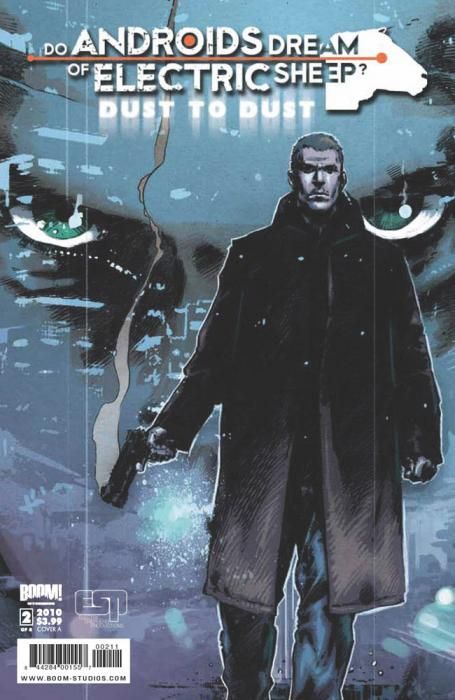Last month, I said that "Robert Adler's art is impressive. He has a clean style with some rough edges that suits the writing and alters his style for each character." This month, I'll do myself one better and say that I love Adler's art in the second issue of "Do Androids Dream of Electric Sheep?: Dust to Dust" and that it's easily the best part of the issue despite Chris Roberson writing a solid, intriguing comic that uses the basic elements of Philip K. Dick's world to create his own spin on things. I was pleasantly surprised with the first issue and the second one surprised me again by being better than the first.
This issue begins by following up on the revelation that Charlie Victor, a hunter of androids, is himself an android, while Reed is an empath as they work out a way to do the job of hunting down a group of rogue androids. Reed doesn't want to help, wanting to go back on the medication that dulls his ability to feel the emotions of others, but that ability is key to tracking down machines that look like people, but have no feelings. They've got a solid 'odd couple' dynamic to their relationship that works well with Roberson not pushing things too far yet, mostly keeping things professional despite some early questioning of what's going on by Reed.
Where the writing doesn't work as well is the plot surrounding Samantha Wu, a researcher trying to figure out how to save all of the animals dying because of the radiation and dust in the air. Here, Roberson introduces the high place in society that animals have in the novel and, also, the Mercerism religion. However, unlike the android hunting plot, this one feels more forced, like it's there only to show how those two parts of the novel came to be. Hopefully, it will connect into the main plot in future issues, but, right now, it seems unnecessary.
Adler's style in those scenes is distinct from the one he uses elsewhere, though. For the Wu scenes, he uses a more suggestive, minimal, cartoony style ala Cliff Chiang or Javier Pulido. It works with the plot since it's a softer story compared to the harshness of hunting androids, or androids plotting to take down humanity. For the rest of the issue, Adler uses a sketchy, harsher style, particularly for Reed who looks unbalanced. He tightens his pencils for Charlie a little, making them look visually distinct. The one area where his art is a little weak is the panel to panel flow since many pages only have four panels and don't lend themselves to smooth transitions.
I wasn't expecting to like "Dust to Dust" since prequel comic series for novels, TV shows, and movies tend to be pretty bad, but this series has started off strong. Roberson's decision to have the android hunters be an android and an empath give that plot a unique feel, while Robert Adler's art jumps off the page, demanding to be poured over. Fans of Dick's work should read this series.

